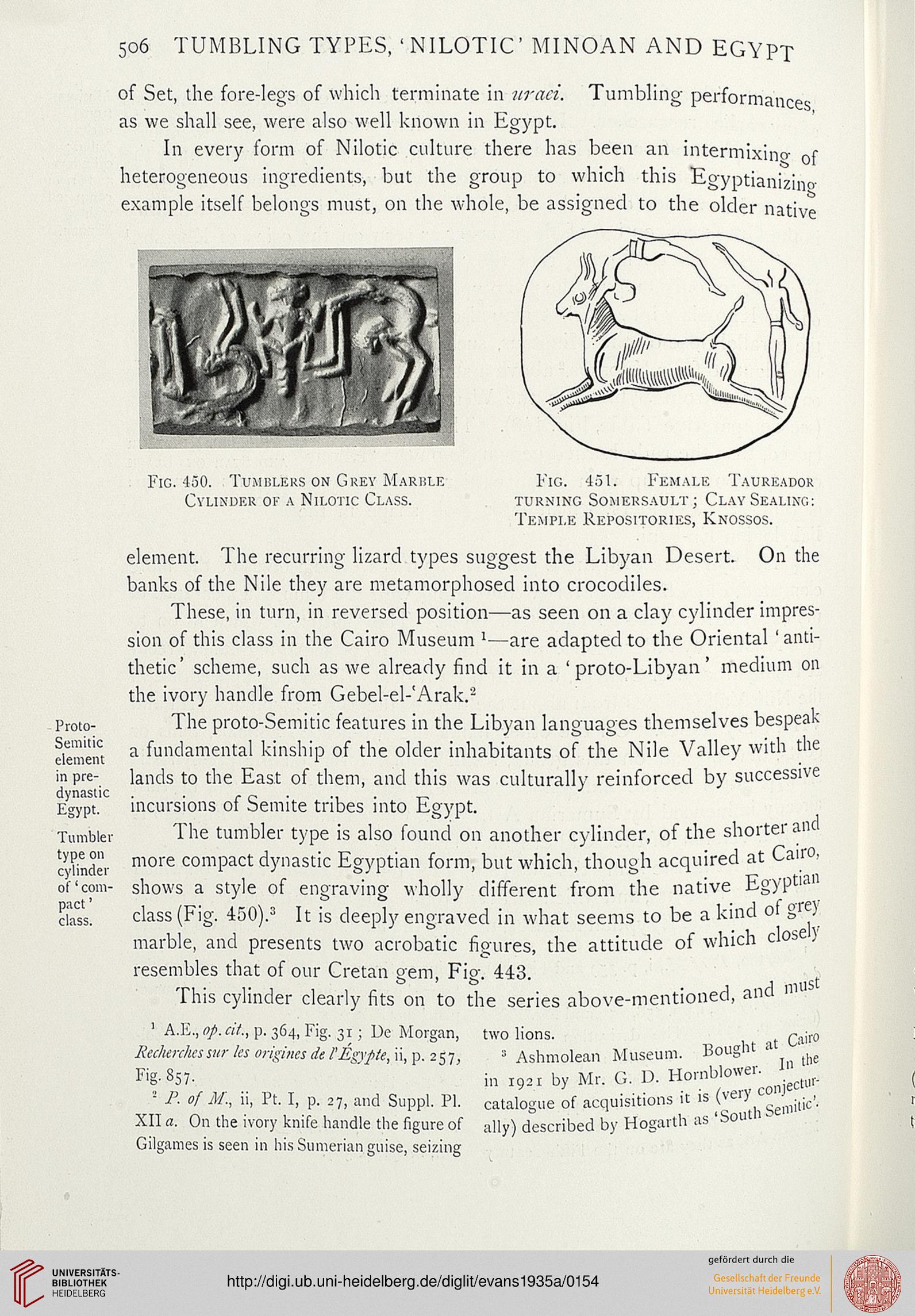506 TUMBLING TYPES, 'NILOTIC MINOAN AND EGYPT
of Set, the fore-legs of which terminate in iiraci. Tumbling performances
as we shall see, were also well known in Egypt.
In every form of Nilotic culture there has been an intermixing of
heterogeneous ingredients, but the group to which this Egyptianizihp-
example itself belongs must, on the whole, be assigned to the older native
Proto-
Semitic
element
in pre-
dynastic
Egypt.
Tumblei
type on
cylinder
of' com-
pact '
class.
Fig.
450. Tumblers on Grey Marble
Cylinder of a Nilotic Class.
Fig. 451. Female Taureador
turning Somersault; Clay Sealing:
Temple Repositories, Knossos.
On the
element. The recurring lizard types suggest the Libyan Desert,
banks of the Nile they are metamorphosed into crocodiles.
These, in turn, in reversed position—as seen on a clay cylinder impres-
sion of this class in the Cairo Museum '—are adapted to the Oriental ' anti-
thetic' scheme, such as we already find it in a ' proto-Libyan' medium on
the ivory handle from Gebel-el-Arak.2
The proto-Semitic features in the Libyan languages themselves bespeak
a fundamental kinship of the older inhabitants of the Nile Valley with the
lands to the East of them, and this was culturally reinforced by successive
incursions of Semite tribes into Egypt.
The tumbler type is also found on another cylinder, of the shorter and
more compact dynastic Egyptian form, but which, though acquired at Cairo,
shows a style of engraving wholly different from the native Egyptial
class (Fig. 450).3 It is deeply engraved in what seems to be a kind of grey
marble, and presents two acrobatic figures, the attitude of which clos
resembles that of our Cretan gem, Fig. 443.
This cylinder clearly fits on to the series above-mentioned, and hi
1 A.E., op. at, p. 364, Fig. 31 ■ De Morgan, two lions.
Rccherchcs mr les engines de I'Egxpte, ii, p. 257,
Fig. .857.
! P. of M., ii, Pt. I, p. 27, and Suppl. PI.
XII a. On the ivory knife handle the figure of
Gilgames is seen 111 his Sumerian guise, seizing
„ ,,f at Can'0
3 Ashmolean Museum. U0tioni ^
i„ I92i by Mr. G. D. Hornblowe, Jecwf
catalogue of acquisitions it is (very ^
ally) described by Hogarth as bout. -
of Set, the fore-legs of which terminate in iiraci. Tumbling performances
as we shall see, were also well known in Egypt.
In every form of Nilotic culture there has been an intermixing of
heterogeneous ingredients, but the group to which this Egyptianizihp-
example itself belongs must, on the whole, be assigned to the older native
Proto-
Semitic
element
in pre-
dynastic
Egypt.
Tumblei
type on
cylinder
of' com-
pact '
class.
Fig.
450. Tumblers on Grey Marble
Cylinder of a Nilotic Class.
Fig. 451. Female Taureador
turning Somersault; Clay Sealing:
Temple Repositories, Knossos.
On the
element. The recurring lizard types suggest the Libyan Desert,
banks of the Nile they are metamorphosed into crocodiles.
These, in turn, in reversed position—as seen on a clay cylinder impres-
sion of this class in the Cairo Museum '—are adapted to the Oriental ' anti-
thetic' scheme, such as we already find it in a ' proto-Libyan' medium on
the ivory handle from Gebel-el-Arak.2
The proto-Semitic features in the Libyan languages themselves bespeak
a fundamental kinship of the older inhabitants of the Nile Valley with the
lands to the East of them, and this was culturally reinforced by successive
incursions of Semite tribes into Egypt.
The tumbler type is also found on another cylinder, of the shorter and
more compact dynastic Egyptian form, but which, though acquired at Cairo,
shows a style of engraving wholly different from the native Egyptial
class (Fig. 450).3 It is deeply engraved in what seems to be a kind of grey
marble, and presents two acrobatic figures, the attitude of which clos
resembles that of our Cretan gem, Fig. 443.
This cylinder clearly fits on to the series above-mentioned, and hi
1 A.E., op. at, p. 364, Fig. 31 ■ De Morgan, two lions.
Rccherchcs mr les engines de I'Egxpte, ii, p. 257,
Fig. .857.
! P. of M., ii, Pt. I, p. 27, and Suppl. PI.
XII a. On the ivory knife handle the figure of
Gilgames is seen 111 his Sumerian guise, seizing
„ ,,f at Can'0
3 Ashmolean Museum. U0tioni ^
i„ I92i by Mr. G. D. Hornblowe, Jecwf
catalogue of acquisitions it is (very ^
ally) described by Hogarth as bout. -





